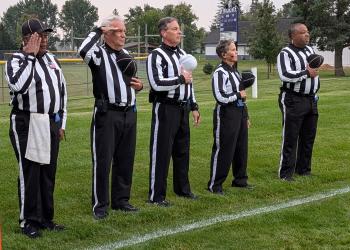Title IX and Sports Medicine Have Grown Together
Staff Reflection by Dr. Bill Roberts
Posted: Tuesday, March 1, 2022 - 11:07 AM

Dr. Bill Roberts
The Title IX federal law, now approaching 50 years old, benefitted women and girls who had been functionally “banned” from sports competition. I graduated from high school in 1970. The girls in my graduating class had four physical activity choices: cheerleading, drill team, gymnastics and synchronized swimming. My daughters, graduating from high school in 1999 and 2003, respectively, participated in soccer, cross country, Nordic Skiing and track and field with many other sports choices open to them and their classmates.
Girls want the opportunity to compete and thrive when given the chance. Title IX forced change in a culture clinging to Victorian Age beliefs about exercise. The idea that vigorous physical activity was bad for women and damaged the reproductive system has slowly disappeared over the past 50 years. It is easy to forget that until 1984 the longest distance race allowed for women in Olympic competition was 800 meters. Women who wanted to run the marathon distance prior to, and even after, Title IX had to lie about their sex to gain entry. Once the sex discrimination wall came down, high schools and communities developed programs and opportunities for girls to compete (although not all willingly and not all equally). As more girls have entered competitive sport, more women have stepped into coaching and officiating roles, giving young athletes of both sexes much needed role models.
Implementing the new law impacted my career. In 1979, as a family medicine resident with an interest in sports medicine, the surge in girls’ sports generated by Title IX gave me opportunities to work the sidelines of MSHSL State Tournaments and expanded the number of patients seeking care for sports related problems. Doubling the number of state tournaments left a gap on the sidelines early in my career. While filling that gap, I have witnessed the tremendous growth in girls’ sports participation and the increase in the quality of performance. Increases in the number of participants and in the time spent training also increased the prevalence of problems associated with competitive physical activity. With time and research effort, it became clear that boys and girls were both equal and different when it came to sports injury and sport related problems.
Both sexes train hard, compete fiercely, and get injured during training and competition. Turning to performance-enhancing substances to gain an edge is always a concern. Adding girls’ sports put more focus on overuse injury, concussion, eating disorders, and mental health and helped trigger an exponential increase in our knowledge of the causes and the management of these problems. With the increased number of girls in competition and training, we also saw an increase in non-contact anterior cruciate (ACL) tears, especially in soccer and basketball. Girls rupture their ACL knee ligaments up to eight times more frequently than boys. We have learned that the prevalence of ACL injuries can be reduced with strength and motor control training. Programs like the international soccer federation “Plus 11” warmup for soccer have reduced ACL injury in boys and girls. While the ligament can be reconstructed, the damage to the joint surface within the knee cannot be reversed and athletes with ACL tears have total knee replacements 10 to 20 years earlier than their peers without ACL tears. So, reducing ACL tears is important for long term health.
Girls sports, like boys, has a dark side. Girls have more concussions than boys playing the same sport and sometimes it takes longer for girls to recover from concussions. Body image is prominent in girls sports and not eating the calories required to support high level physical activity is considered disordered eating. The energy deficiency caused by inadequate food intake results in reduced bone mineral development and is associated with increased injury rates, especially stress fractures and overuse injuries. The loss of normal monthly periods and delayed onset of the menses is caused by this energy deficiency. This change in the menstrual cycles is a built-in measure of energy reserves for girl athletes. We all must be aware of disordered eating in athletes of both sexes.
We are seeing the fruits of high school girls sport in the colleges, in the Olympics, and in international competitions. The benefits of sport participation spill over into all parts of life. Sports participation helps children develop teamwork, drive, and confidence. While sport alone cannot be credited for the dramatic increases in women participating in all professions, I think it has helped clear the path and given girls permission to think big for life beyond high school. When I started medical school at the University of Minnesota in 1974, 20 percent of my classmates were women and that was a record. When my daughter started medical school at the University of Minnesota in 2003, her class was 52 percent women; a remarkable change that took too long to happen.
Title IX and the women who pushed for its success on the field of play and in the walk of life brought sport and society to a higher level.
Bottom line: Girls want to be challenged in sports and in the classroom just as much as boys. Sports have been shown to increase confidence that certainly benefits other life choices. Title IX has taken the girls from the shadows and allowed full and equal benefits of sport participation, and helped young women see their potential in life and society.





